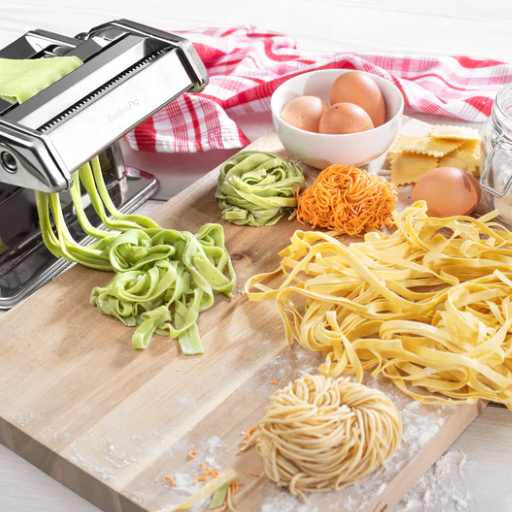Nothing compares to the taste and texture of home-made pasta. But getting that perfect firmness and elasticity is challenging without the right equipment. This blog post aims to help you choose the best pasta maker for your cooking needs. We will look at different types of machines available in the market, including traditional manual models or modern electric ones; their features, advantages, and disadvantages will also be discussed here. Whether you are an experienced chef or just starting in the kitchen, our detailed guide is tailored to ensure that every dish of fresh noodles made by hand from scratch turns out perfect. So, let us begin on this journey towards improving your pasta-making skills!
What Are the Different Types of Pasta Makers?
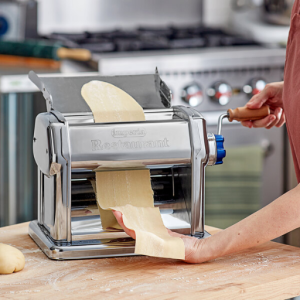
Image source: https://www.webstaurantstore.com/
There are two main pasta machine types: manual and electric.
Manual Pasta Makers
Manual pasta makers, or hand-crank models, require you to turn a handle. They give you more control over the thickness or texture of the pasta. This variety tends to be cheaper, sturdier, and more portable, so it’s perfect for hands-on pasta lovers who love taking their work with them on trips.
Electric Pasta Makers
Electric appliances automate most parts of the process—from mixing ingredients to extruding dough—which can save time if you’re in a hurry or just want to make bigger batches without having to do everything manually every time. Some also come with different settings and attachments for making various pasta shapes.
Each kind has its advantages; which one works best for you depends on your preferences and specific needs when making noodles at home.
Manual Pasta Maker: Advantages and Disadvantages
Advantages:
- Control Over Texture and Thickness: Manual pasta machines allow you to control the texture and thickness of pasta. This allows you to achieve the desired consistency for different types of pasta.
- Affordability: If you are on a budget, manual pasta makers are a good choice because they generally cost less than their electric counterparts.
- Durability: These machines are often made from durable materials such as stainless steel, ensuring they last long.
- Portability: Manual pasta makers can be easily moved around or stored away in kitchens with limited space since they do not require electricity.
Disadvantages:
- Labor-Intensive: Manual pasta makers take too long to use and demand more physical energy, so they might not work well for some people.
- Limited Features: Unlike electric models that come with many attachments and options, manual pasta makers have fewer features, hence only allowing one to make certain types of pasta.
-
Learning Curve: Mastering using a manual pasta maker takes time, especially for beginners, thus requiring patience and practice.
Electric Pasta Maker: Is It Worth the Investment?
When buying an electric pasta maker, it is crucial to consider its benefits and drawbacks. Ease of use and time savings are among the top advantages. Electric models automate many steps in making pasta by hand, like kneading or rolling dough, making the process much faster and more efficient. This saves a lot of time, especially for people who make pasta often or have little time.
Another good point is that this type of machine produces consistently high-quality pasta. Most electric machines come with several settings and attachments, so you can make different types of pasta with the same texture throughout. This feature is particularly useful for culinary enthusiasts who like to try out various recipes involving different kinds of pasta.
However, They cost more than manual ones. Affordability becomes an issue when occasional makers are concerned or individuals operating within their budgets. Besides being expensive initially, space requirements may be higher, while cleaning and maintenance might prove more demanding with these models.
Ultimately, an electrical appliance could be justified if convenience, speed, variety, and durability matter most to you. However, reliability and durability could also be more significant considerations based on how regularly one uses it or even if they want every batch to come out perfect all the time without fail.
Roller and Cutter Machines: How Do They Work?
The concept of roller and cutter machines is simple, but it works effectively. Initially, the pasta dough should be passed into a number of adjustable rollers, where it is squashed to the desired thickness. This procedure can be repeated repeatedly for specific types of pasta and how thick or thin it should be. After the dough has been rolled thin enough, it passes through several cutters.
These cutters come in different sizes and shapes for making various forms of pasta, like spaghetti fettuccine or even lasagna sheets. Some machines have interchangeable cutter attachments, hence their versatility. What makes roller and cutter machines great is that they produce uniformly thin pasta, which cooks well due to its even texture throughout. Furthermore, controlling it manually allows one to try different types of dough thicknesses while taking a hands-on approach toward pasta-making.
How to Choose the Best Pasta Maker for Your Kitchen?
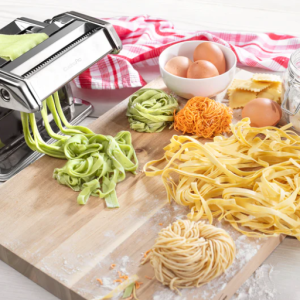
Some requirements should be considered when selecting a pasta maker, among all the others in your kitchen. First, it is necessary to decide how often you will utilize it and how much of this product will be needed at once. A manual model may do this if making pasta from time to time only because such devices cost less money than electric ones, and besides, they are smaller in size, too. But if they are used regularly or preparing large amounts of dough, then an automatic machine would be more appropriate as it saves both time and effort considerably. Moreover, one should also think about what kind of noodles he wants to cook – specific machines come along with different attachments for various shapes and sizes, thus adding versatility to their workmanship; another aspect concerns space availability as well as simplicity in cleaning procedures, which means that while buying this appliance one must ensure that its dimensions fit the overall layout of his/her kitchen plus provide easy access for washing purposes whenever required without any hassles whatsoever; finally let budget constraints together with user reviews guide your choice among various options available on the market today.
Key Features: What to Look for in a Pasta Maker?
While choosing a pasta maker for your kitchen, there are various features to bear in mind:
- Type of machine: Choose between manual and electric pasta makers. Manuals are usually smaller and cheaper but require more work, while electrics are faster and more convenient, especially if large quantities are made.
- Material and Durability: The best machines should be made of stainless steel or any other strong material that can last long without breaking easily. Avoid those with many parts made of plastic because they tend to wear out quickly.
- Adjustable Settings: Choose a machine with different settings for dough thickness. This is important as it allows you to make various types of pasta, from lasagna sheets to angel hair spaghetti.
- Attachments/Accessories: Some machines come with several attachments for creating diverse pasta shapes. So consider what kind(s) of pasta you like eating most frequently before buying any particular model—ensure its compatibility with such types.
- Ease of Use/Cleaning: Choose user-friendly models with clear instructions printed on them; this will save time during the preparation process. Also, look out for those with detachable parts that can be cleaned using dishwashers.
- Size/Storage: Don’t forget about space; select only those makers that fit well into your available kitchen space without causing much congestion later. Some brands even provide compact designs for easy storage when not in use.
If these points still seem confusing or you’re unsure about anything else concerning purchasing decisions, feel free to consult reliable sites where top-rated options have been published alongside their detailed descriptions and customers’ feedback—this way, one gets better ideas before finalizing orders!
Top Brands: Marcato Atlas 150, Imperia, and More
Quality and versatility distinguish the Marcato Atlas 150 from other pasta makers. This machine is manufactured in Italy and has a muscular build. It can make different types of pasta because it offers numerous thickness settings. Due to its strength and precision, which are valued by users, it can be relied upon for consistent results.
Another brand that enjoys high ratings is Imperia. It is known for being sturdy and user-friendly. With a classic design and dependable performance, it efficiently produces various pasta shapes. Many reviews say this appliance lasts long and provides an authentic experience of making homemade noodles.
In addition, people love the Philips Pasta and Noodle Maker because it is packed with innovation and automation. This electric model simplifies preparing fresh pasta by automatically mixing, kneading, and extruding dough into desired shapes within minutes. Therefore, if you want your meal done quickly without sacrificing taste, this device will suit you best.
By looking at these three leading manufacturers—Marcato Atlas 150, Imperia, and Philips—one should be able to select a pasta maker that corresponds with their unique requirements, whether they lean more towards traditional craftsmanship or state-of-the-art technology.
Pasta Maker Attachments for KitchenAid Stand Mixers
The most suggested pasta maker attachments for KitchenAid stand mixers are the KitchenAid 3-Piece Pasta Roller & Cutter Set, KitchenAid Gourmet Pasta Press, and KitchenAid Pasta Extruder.
Many people like the KitchenAid 3-Piece Pasta Roller and Cutter Set because it can be easily used in many different ways. This set includes a pasta roller that kneads and rolls sheets of pasta and two cutters for making fettuccine and spaghetti noodles. Homemade lasagna lovers should try this product out; not only does it have strong construction quality, but it also gives accurate results every time one uses it.
What sets the KitchenAid Gourmet Pasta Press apart is its ability to extrude six types of pasta, such as spaghetti, bucatini, rigatoni, fusilli, or even macaroni, in two different sizes. It’s great for people who like trying out different shapes since they don’t need to worry about cleaning too much, thanks to an easy-clean design coupled with consistent outputting. This best suits those who enjoy experimenting with various kinds of pasta.
Meanwhile, the last among them all—the Kitchen Aid Pasta Extruder—has been highly recommended because it effortlessly produces authentic Italian-style pasta. Its six discs are meant to create diverse shapes, thus ensuring that any person who is fond of eating noodles will find their ideal match here.
How to Make Fresh Pasta at Home?
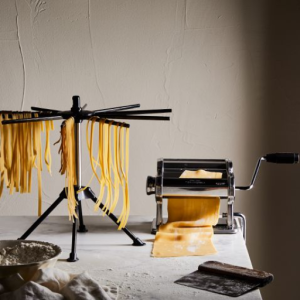
Creating a new pasta in your house is rewarding and only requires a few ingredients plus steps. Combine 2 cups of all-purpose flour with three large eggs, mixing until dough forms, in a bowl. Knead the dough on a floured surface for about ten minutes till smooth and elastic. Wrap it with plastics, then rest for at least thirty minutes. After resting, divide it into portions – use a rolling pin or pasta roller machine to make thin sheets from each portion. At last, cut them into their preferred shape using a knife or pasta cutter attachment, and cook in boiling salted water for three minutes until “al dente.” Serve with your favorite sauce.
Essential Ingredients for Homemade Pasta
To create tasty homemade pasta, you’ll only need a few essential ingredients that you most likely already have in your kitchen:
- All-Purpose Flour: This versatile flour forms the main component of your pasta dough. You can use “00” flour for a finer texture or semolina flour for a coarser, more traditional one.
- Eggs add moisture and richness to bind the flour into an elastic, smooth dough. Fresh, large eggs are usually used.
- Salt: A pinch of salt is important as it enhances the taste of pasta, both in the dough itself and when boiled in water.
- Olive Oil (optional): Some recipes call for adding olive oil to give the dough extra smoothness and richness.
Collectively, these constituents provide an excellent base on which different shapes/styles of pasta can be made, enabling individuals to savor fresh homemade pasta with the least labor but maximum flavor.
Step-by-Step Guide to Making Pasta Dough
- Measure Components: Begin by gauging all the necessary ingredients. Use two cups of general flour, three big eggs, and a pinch of salt. For added richness (optional), add one teaspoon of olive oil.
- Construct Flour Well: Create a mountain with the flour on a clean surface or in a large mixing bowl and dig a hole in its middle part. Drop the eggs into the dug well and add salt (and olive oil if necessary).
- Blend Materials: Gradually whisk eggs using a fork while incorporating flour from the well’s edges. Mix until you have a shaggy dough.
- Knead Dough: Transfer smooth elastic dough onto a floured surface, then knead for about 8-10 minutes. Sprinkle more flour if the dough is sticky.
- Rest Dough: Wrap the kneaded dough in plastic wrap and let it rest for at least thirty minutes at room temperature. The rest period relaxes the gluten, making rolling the dough easier.
- Spread Out Dough: Following its rest, cut dough into smaller pieces before rolling each into approximately 1/16 inch thick thin sheets using a pasta roller or rolling pin.
- Shape Pasta: Cut rolled-out pasta dough to achieve desired shapes; for instance, fettuccine can be made by slicing noodles with a knife, or tagliatelle/lasagna sheets may be created by using pasta cutter attachments.
- Boil Pasta: Put fresh pasta into a pot containing boiling salted water and cook it for 2-3 minutes until al dente. Ensure that you watch over it because fresh pasta cooks fast.
-
Serve and Enjoy: Drain cooked pasta, then mix with any sauce you like best. Have fun eating your homemade pasta, which has just been prepared!
Using a Pasta Maker: Tips and Tricks for Beginners
- Beginning with Little Balls of Dough: Divide the dough into smaller, more manageable pieces before running them through the machine. Rolling becomes easier and more accessible even when the portions are kept small.
- Flour It Up: Dust your dough lightly with flour and do the same for the pasta maker’s rollers to prevent sticking. Apply as required, but don’t overdo it if you want to maintain the consistency of your dough.
- Thinning in Stages: When working on a pasta roller, start by rolling out the dough at its widest setting. Gradually reduce thickness by adjusting it in steps until you reach the desired thinness. This method helps avoid tearing and ensures an equally smooth roll-out.
- Fold and Roll: Once rolled out initially, fold the dough into thirds, just like one would do to a letter, and feed it back through the machine several times before reducing thickness.
- Choose Appropriate Attachments: Take time to learn about the various pasta-cutting attachments that come with your device. With spaghetti, fettuccine, and other shapes, making any form of pasta is simplified while guaranteeing uniform cuts.
Following these hints will enable you to master using a pasta machine for cooking delicious meals.
What Are the Benefits of Using a Pasta Maker Machine?
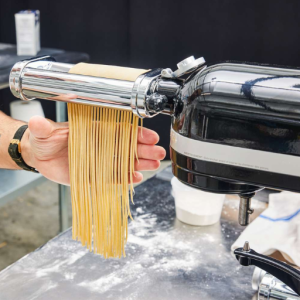
There are many advantages to using a pasta maker machine. First, it can help you make delicious homemade pasta, which is usually tastier and healthier than the one you buy in the shop. You can control what goes into it, avoid preservatives, and adapt it to your diet. Secondly, this device guarantees evenness in the thickness and shape of the noodles, ensuring that each batch turns out professional-looking and identical. Thirdly, once you learn how to operate it properly, it saves tons of time! Making pasta with its help takes much less effort than doing everything by hand over the stove or oven top. Last but not least important – experimenting with different forms of pasta can be fun! Trying out various shapes, such as tagliatelle or bowties, along with new recipes, will definitely enhance your cooking skills while bringing joy to those who eat your dishes.
Quality and Taste of Fresh Pasta vs. Dried Pasta
When we talk about quality and taste, there are a few main distinctions between fresh and dried pasta. Soft wheat flour based on eggs makes fresh dough smooth and fragile, quickly absorbing any sauce and giving it a silky texture in the mouth, whereas hard durum cooked only with water results in a chewy, dense kind that holds itself together even after several hours of boiling, thus being an excellent choice for example, bolognese spaghetti or lasagne verde. But also, because they do not require refrigeration like their counterparts would need, dried ones become more flexible in storage. Besides having a more robust flavor that pairs well with most ingredients, making them beautiful options whenever we want to highlight our dish around these little wonders.
Time and Effort: How a Pasta Maker Simplifies the Process
Using a pasta maker can significantly simplify making pasta at home. Typically, rolling and cutting dough by hand take too much time and require a lot of energy. These activities are also laborious and need consistency to achieve desirable results. However, with a pasta maker, these steps are automated, enabling you to make even-sized pieces of professional-quality pasta faster. Most pasta makers have different thickness settings for the dough and various attachments for cutting different shapes, making them more useful overall. Moreover, electric ones mix, knead, and extrude automatically, thereby still reducing manual labor. This saves time and cuts down on cleaning up, thus making fresh homemade pasta accessible to busy home cooks.
Customizing Your Pasta: Thickness Settings and Pasta Shapes
To customize your pasta, you must adjust the thickness settings and choose different pasta shapes to fit various recipes or preferences. Most feature adjustable thickness settings, from the thinnest angel hair pasta to thicker sheets used for linguine or lasagna. Generally, these settings are numbered 1 – being the thinnest- through to 9 – which is the thickest one. This flexibility makes it possible to attain the desired consistency in any dish selected and ensure that such noodles will cook uniformly and hold sauce properly.
In terms of shapes, many appliances have several attachments that enable users to create classics like spaghetti, fettuccine, or pappardelle, besides more complex forms such as shells or penne rigate. Moreover, some advanced models even allow stuffing ravioli together with tortellini, providing infinite customization options so that every home chef can make their own authentic dishes based on their unique taste buds.
How to Troubleshoot Common Problems with Pasta Maker
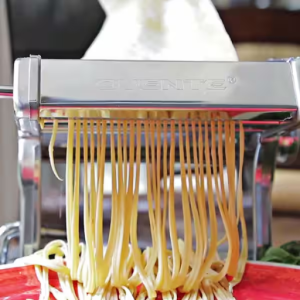
Machines?
With pasta maker machines, there will be several common problems that you may face, but they can often be fixed by following some troubleshooting steps. Read on for some suggestions:
- Dough Sticking to Rollers:
- Before using it, dust the rollers with a bit of flour.
- Ensure that the dough is neither too wet nor too dry – it should be slightly tacky but not sticky when touched.
- Machine Jamming or Stopping:
- Look for any clogged pieces of dough in the machine and clean them out.
- Don’t overload the machine – feed smaller portions of dough through the rollers.
- Uneven Dough Sheets:
- Before feeding it into the machine, ensure the dough is flattened evenly.
- Gradually reduce the thickness setting instead of moving from thick to thin too quickly.
- Pasta Not Cutting Properly:
- Check if cutting attachment is clean and properly installed..
- Let it rest until it becomes firm if the pasta is too soft.
By adhering to these fixes, you can keep your pasta maker running smoothly so that it results in perfect pasta every time.
Fixing Dough Sticking Issues
To fix the dough sticking to the rollers, start by modifying the moisture content of the dough; it tends to stick if it is too wet. Sprinkle small amounts of flour over it and knead till you get to the required consistency, which will help in absorbing excess moisture, thus preventing adhesion. Always clean rollers thoroughly before using them, ensuring no traces of dough or other material are left behind. It may also be necessary to lightly dust rollers with flour, as this adds another layer of protection against sticking. These steps will effectively prevent and solve any problems related to dough sticking to your pasta maker machine.
Addressing Roller and Cutter Misalignments
The first thing you need to do when dealing with cutter and roller misalignments in your pasta maker machine is to ensure that it is placed on an even surface that does not shake quickly. You can then measure from one side to another to see if they align correctly; if not, adjust according to the manufacturer’s instructions for roller settings. Also check whether obstructions are preventing smooth movement between these two parts. Cutters should be well fixed and aligned right with rolls, but in case they have been removed, take them out again and put them back in position while confirming their alignment is correct, too. Always make routine checks, plus following what the producer says will help keep everything working well, thus avoiding such alignment problems for good besides enhancing its performance.
Resolving Problems with Thickness Settings
To fix problems with how thick your pasta maker machine forms noodle sheets, ensure it is put together correctly, and all parts are in place. Look at the instructions for details about setting thicknesses; an incorrect adjustment may cause uneven dough. If your dough comes out too thin or thick, begin by putting rollers on the widest setting and gradually reducing them until you get the desired outcome. Flour dough evenly and not too sticky because it affects consistency. Clean the machine regularly to prevent build-up, which interferes with thickness settings. Doing this will ensure uniformity and accuracy in thickness when making spaghetti using a pasta maker machine.
Frequently Asked Questions (FAQs)
Q: What is the best pasta maker for beginners?
A: A manual pasta machine like the CucinaPro Pasta Maker Deluxe Set is highly recommended for beginners. It has adjustable thickness settings and is easy to use.
Q: How does a pasta roller work?
A: A pasta roller flattens the dough into thin sheets. You feed the dough through the rollers multiple times, adjusting the thickness until you achieve the desired thickness.
Q: Is the Marcato Atlas 150 Pasta Machine suitable for making pasta from scratch?
A: The Marcato Atlas 150 Pasta Machine is excellent for making pasta from scratch. It has an adjustable thickness setting and is very sturdy, making it a favorite among pasta enthusiasts.
Q: What’s the difference between a pasta machine and a noodle maker?
A: A pasta machine typically focuses on rolling and cutting various pasta shapes, such as spaghetti, fettuccine, and lasagna sheets, while a noodle maker may have additional features to make specific noodle types, often used in Asian cuisine.
Q: Can I use a KitchenAid pasta attachment?
A: Yes, the KitchenAid pasta attachment is an excellent option if you already own a KitchenAid mixer. It allows you to roll and cut pasta sheets conveniently.
Q: What should I look for in a stainless steel pasta maker?
A: When looking for a stainless steel pasta maker, check for durability, ease of use, adjustable thickness settings, and whether it includes rollers and cutters for pasta. Models like the Atlas 150 Pasta Machine are often recommended for their quality.
Q: How do you properly dry homemade pasta?
A: To properly dry homemade pasta, spread it on a clean surface or use a pasta drying rack. Make sure the pasta is not touching to prevent sticking. Let it air dry for a couple of hours before cooking or storing.
Q: Is the hand crank or motorized pasta maker better?
A: The choice depends on your preference. A hand crank pasta maker gives you more control and is quieter, while a motorized one is faster and requires less effort.
Q: Are there adjustable thickness settings in pasta makers?
A: Yes, many pasta makers come with adjustable thickness settings. For example, the Marcato Atlas 150 Pasta Machine provides nine adjustable thickness settings to help you achieve the perfect pasta sheet thickness.
Q: What accessories are helpful when using a pasta machine?
A: Helpful accessories include a pasta drying rack, cutters for different pasta shapes, and a KitchenAid pasta attachment if you have a KitchenAid mixer. These tools can make the pasta-making process more accessible and more versatile.












